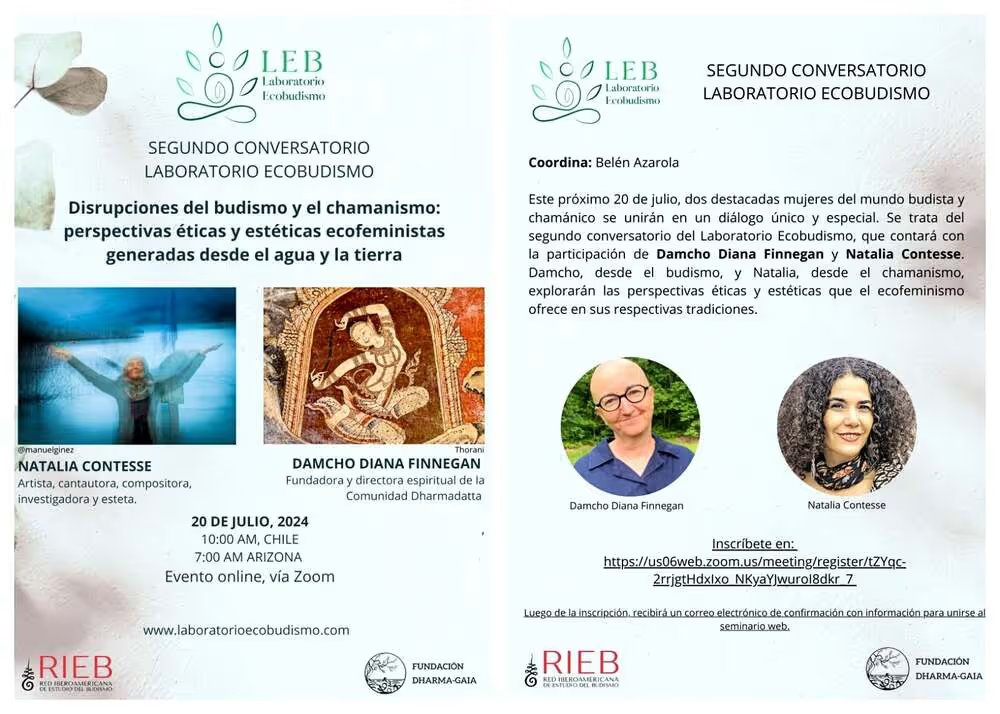
This July 20, two women from the Buddhist and shamanic world will meet in a particularly special dialogue: this is the second conversation of the EcoBuddhism Laboratory; this time with Damchö Diana Finnegan and Natalia Contesse. Both, from their own life contexts, experiences, studies and spiritual lives, will carry out a conversation about ecofeminism and its disruptions. Both in Buddhism, in the case of Damchö, and in shamanism, as Natalia observes, they will talk about what ethical and aesthetic perspectives are possible to interpret, live and experience from an ecofeminism between the two traditions, taking water and earth as elements of nature.
Damchö is a lay Buddhist teacher, who has been on the Buddhist path for more than 25 years and is the co-founder of the Dharmadatta Buddhist nuns community, the Budadharma Institute and the publishing house Albricias. All are instances for learning and disseminating the Dharma, as well as attention to the role of women in Buddhism, their current conditions and the vision of women in Buddhist practice from a gender perspective. Damchö is a tireless teacher, she has been taking courses in Buddhism for years and moving her retreats to different countries, with special attention to Latin America. Damchö takes ecofeminism as a current of thought and a social movement, which can learn from Buddhism and vice versa, and the latter will be what his talk with LEB will focus on, taking the earth as an element.
Natalia Contesse is an artist, singer-songwriter, composer, aesthete and researcher of popular and traditional Chilean and American culture, who has based her artistic and spiritual learning on folk music and shamanism. Under the teachings of Carmen Vicente, shaman, teacher in the healing profession and artist, Natalia has forged a shamanic path for more than 20 years of her life, combining art with the feminine rite, reading the cycle of nature from the construction of altars, honoring its elements and the ethical and aesthetic value of beauty. Natalia, based on the teachings of shamanism, conceives water as a living aesthetic being. From this consideration, it will establish dialogues with the role of the feminine and the ecosystem value under that element of nature.
We invite you to be part of this wonderful meeting between Damchö and Natalia, to meet and reconnect from two different traditions, which come together by and in land and water!
The EcoBuddhism Laboratory (LEB) emerges as an executing, collaborative, creative and participatory network, which allows us to analyze new interpretations and ideas based on Buddhism, and to interact with various cultural, scientific, academic, educational and other entities that enrich dialogue and the execution of ecological projects and programs in the sanghas. Our intention is to create an interdisciplinary laboratory that allows us to show the ecological actions carried out by the sanghas, as well as to expand the theoretical and experiential interaction between Buddhism and ecology in the multiplicity of areas in which ecological awareness is developed, in a way that is both theoretical and practical support for environmental sustainability.
SIGN UP FOR:
https://us06web.zoom.us/meeting/register/tZYvcO2tqzgqG9GnFDyJKZcLQGjbRpdrtt5l
LINKS:
Ecobuddhism Laboratory
https://www.laboratorioecobudismo.com/
https://www.instagram.com/laboratorioecobudismo/
https://www.youtube.com/channel/UCt5eGdL3CYee0xaql0RaqRQ
Dharma-Gaia Foundation
https://www.fundaciondharmagaia.com/
Buddhistdoor in Spanish
Special Edition: “Buddhism, Ecology and Climate Change”
Global Systemic Crisis and Buddhism: Towards a Paradigm Shift by Jordi Solé Ollé










